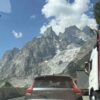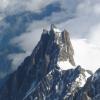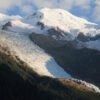Jodie Mayo is RAW Travel’s Mont Blanc specialist and offers some advice on the most commonly asked questions she gets posed on walking on the TMB:
- What’s the weather like during the season?
- When is the best time travel?
- When can I see wildflowers?
Let’s start with the weather. The French Alps are known for their strong and defined seasons. With such great weather, it’s no wonder Chamonix has a large culture of sport. In the region around Mont Blanc – from France to Italy and Switzerland – people are obsessed with skiing! Most of the Alps will be covered with snow in a good season, even right down into the valleys and Chamonix itself.
Fun Fact: You will notice the harmonious architecture of the towns in the Alps: the wooden and stone chalets blend into the natural surroundings. Many chalets in the European Alps were originally used as seasonal farms for dairy cattle, which would be brought up from the lowland pastures during the summer months. The herders would live in the chalet and make butter and cheese in order to preserve the milk produced. These products would then be taken, with the cattle, back to the low valleys before the onset of the alpine winter.

On average, Chamonix receives from 700cm to 1000cm of snow during the winter season, which runs from the end of November to mid-April, depending on whether it’s a ‘good’ season.
So what does this mean for us, the hikers?
The official start of the hiking season is the second weekend of June until the second last weekend of September. Just before the start of the hiking season in 2016, Chamonix was still receiving large snowfalls, which meant that on some of the higher passes that we crossed during our Mont Blanc Highlight Tour and Circuit Tour there was still quite a lot of snow underfoot.
The main areas affected at the start of the glorious hiking season are usually the Col du Bonhomme (2329m), Col de la Croix du Bonhomme (2433m) and then the Col de Ferret (2537m) leading into Switzerland.
Our first groups usually walk over more snow than the later groups. This means slightly more work than on clearer paths but the views of snow-capped mountains are spectacular and do make for a great photo!
Towards the end of June, the weather is a lot more stable, with longer hours of daylight and wildflowers covering the hillside until the start of August.

At the start of July you will find soft snow on the passes and clearer trails. Wildflowers are in full bloom for the duration of July. The trails start to get busier in mid-July with the best weather for trekking. Buses on the Italian side start running around 1 July until the end of August; timetables come out during the season.
As we move into August and the European holiday period, the main towns are busy with vacationing Europeans, the trails are surprisingly quiet, and the weather is warmer than June or July. You will still need to bring warm clothing as the temperature can vary quite dramatically even in August. In the 2016 season it snowed in the middle of August, so always be prepared in the Alps for all types of weather.
As we hike into September, the days become shorter and the fantastic autumn colours paint the scenery. The trails get quieter and the cooler weather arrives. The main lifts around the region usually close between 17 and 20 September, which means days can be much longer if this is not taken into consideration when arriving back into Chamonix.

The weather on the Alps can vary, so always be prepared for wet weather, hot weather and very cold weather!
No matter what time you decide to visit this amazing region, Chamonix itself is an intoxicating mixture of incredible mountain scenery, picturesque villages, great nightlife, powerful mountain culture, exquisite cuisine, and world-class hiking, mountain biking and skiing.
There really is something for everyone, which is why we love the area and we are sure you will too!








